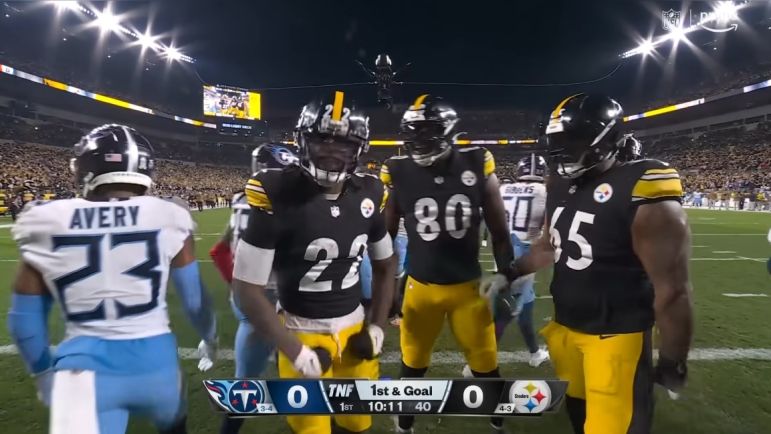No, your eyes didn’t deceive you. The Pittsburgh Steelers found the end zone on their opening possession. The first time all season they’ve scored points on drive number one, it was their first opening drive touchdown since Week 15 of last season against the Carolina Panthers.
Overall, it was a solid drive mixing run and pass. They stayed on schedule for the most part but also found a way to dig themselves out of a hole and not let negative plays ruin their drive. Ten plays, 78 yards, and seven points. Let’s break it down. We won’t talk about every single play, but most of them in chronological order.
1. 3rd and 6, Steelers 26 – Ten-yard completion to WR Allen Robinson
After a short Najee Harris run and a failed RB screen to him, the Steelers were immediately on the edge of another three and out. Pittsburgh came out in 2×2 but ran a sail concept, a three-man route combination of a go, corner, and flat/shallow. They used WR Allen Robinson to come across the formation on the shallow as the third part of the sail concept, dressing it up a little differently but still flooding the Titans’ zone coverage.
Pickett works high to low on his read and works to Robinson. The throw is behind but that appears intentional. Robinson was running across and working towards the window of the next defender and Pickett didn’t want to throw him into a collision. So he threw behind to slow him down and avoid the hit. Robinson adjusted and made the grab for ten yards and a fresh set of downs.
2. 1st and 10, Steelers 36 – Nine-yard completion to RB Jaylen Warren
The very next play. A popular concept in Pittsburgh and around the league this season has been 4×1 sets with a “Fast 4,” meaning someone quickly running out into the flat to be that fourth man. The Steelers have used this formation plenty over the season. The quarterback can take the receiver isolated backside if he likes the matchup (think George Pickens’ 22-yard TD against Jacksonville).
Here, Jaylen Warren sprints to the flat as the “Fast 4” on a designed swing screen. The three receivers to the trips, the top, are blocking by design. Pickett throws it out to him and Warren gets solid blocks from all three, TE Darnell Washington and WRs George Pickens and Robinson. It goes for nine yards to immediately put them in 2nd and 1, a great first down playcall that keeps the call sheet wide open.
3. 2nd and 1, Steelers 45 – Seven-yard run by RB Jaylen Warren
After being a zone-heavy team for the first month of the year, Pittsburgh has wisely and finally leaned on more gap and power schemes. Here, we get a “Dart” scheme with the backside tackle pulling. In this case, RT Broderick Jones. Frontside blocks and washes down while Jones pulls around. Well-blocked and Warren has a lane for seven with a physical finish. First down and this offense is in a rhythm.
4. 1st and 10, Titans 48 – 11-yard catch by TE Connor Heyward
Love this call from OC Matt Canada. Watch some of the best offenses in football and you see all the easy yards they create. The simple concepts, pitch and catch, with a quick and clear read for their quarterback. Not for a home run play but a solid single to keep a drive going.
On this play, the Steelers fake the motion they use on their Zorro Toss with Heyward as he runs across the formation. But instead of a run play, Pickett throws it to Heyward off play-action in the right flat. The Titans are out-leveraged and Heyward is wide open. Pitch and catch and he turns upfield for 11 yards. That’s easy yardage. Quick and wide-open throw in the flat for a first down. That’s what you want to see.
5. 2nd and 15, Titans 42 – 13-yard catch by WR Diontae Johnson
On 1st and 10 after the Heyward catch, the Steelers ran a busted RPO (they used a lot of RPOs in this game, probably more than they have in any game this season). Receivers never looked for the ball, Pickett had to throw it away, and the Steelers were flagged for ineligible man downfield because the ball didn’t come out quickly like it’s designed to.
Normally, a penalty like that would end the Steelers’ drive right there. But they’re able to show some resolve and battle back. Even after an incompletion on 1st and 15 setting up second and long, Pittsburgh gets most of it back on 2nd down. A bit of a broken play but Pickett hangs in the pocket instead of bailing and reducing half the field, keeps his eyes downfield, and finds Johnson underneath. He turns upfield and shows off his YAC ability, picking up 13. To go from 2nd and 15 to third and short is something this offense simply doesn’t do. Of Pittsburgh’s nine plays this season of 2nd and 15 or further, the 13 yards here is their biggest gain. And again, it opened up the playbook on third down.
6. 3rd and 2, Titans 29 – 19-yard catch by WR Diontae Johnson
Of course, you gotta go convert on third down, too. Pittsburgh comes out in 2×2 and runs a smash concept, a flat/corner concept. The throw depends on the underneath defender. If he sinks, throw the flat. If he drives, throw the corner. Here, the corner takes Heyward in the flat, leaving Johnson 1v1 on the safety. Johnson breaks to the sideline and Pickett hits him.
Good throw, good catch, and it’s 19 yards to put Pittsburgh into goal-to-go territory. Right on the end zone’s doorstep.
7. 1st and Goal, Titans 10 – 10-yard run by RB Najee Harris
Pittsburgh puts the ball in the end zone. Again, going back to a gap run. This time, more traditional power with the backside guard – LG Isaac Seumalo – pulling. Like the dart scheme above, the frontside will block down while the guard pulls. Because the DT to the frontside is quickly secured, RT Broderick Jones is able to easily climb to the second level and pick off the linebacker. Seumalo pulls around and sticks to his block while RG James Daniels secures the d-tackle and takes him off his feet. It’s a huge hole for Harris to follow and he punches the ball in for the score.
And look at that reaction. Linemen pumped and Kenny Pickett, a point to the sideline. Maybe to Matt Canada? A little “nice calls, coach” to get you feeling good about the game.
Overall, Pittsburgh did a bit of everything on this drive. Quick passing game for some easy wins, designed downfield throws, Pickett making plays out of structure, and a solid gap scheme that was well-blocked and executed. Obviously, the offense sputtered the rest of the game, largely due to execution issues, but this is how a first drive should look. Hopefully, we see it again.







